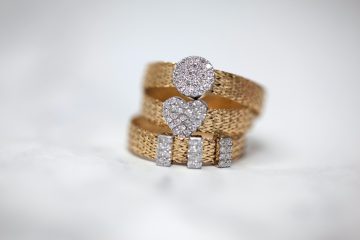Platinum has the chemical designation Pt, density 21.5 g / cm³, and melts at 1772 ° C.
What is real platinum?
The word platinum can be emphasized either platinum or platinum, both variants are just right. Genuine platinum has a fine content of at least 950 thousandths, ie 95% platinum. The remaining 5% is usually copper, but can also be cobalt, tungsten, or palladium.
Within a few years, we will probably see platinum jewelry in 850 and 900 thousand platinum. These fines along with 950 are all common in Japan, which is the country where platinum jewelry is most common. Platinum jewelry is one of the rarities, most often it is the exclusive jewelry that one chooses to make in this metal.
Platinum is a separate metal, not to be confused with white gold (gold mixed with palladium to turn white).
Platinum has not been known for as long as gold and silver. Although platinum was used by Indians in South America before Columbus to make smaller ornaments, it was not until the eighteenth century that the proper properties and value of platinum became known and appreciated to a greater extent.
Towards the end of the 19th century, platinum began to hurt, and demand was greater than the supply, with a sharp rise in prices as a result. In jewelry production, they began to look for replacement materials, which however should be noble, durable and with the same appearance as platinum. This resulted in the development of white gold in the early 1900s. Today, white gold dominates platinum in jewelry production.
What is platinum? Platinum is the most exclusive of all base metals and has become one of the most common materials in choosing engagement and wedding rings. That’s 30 times more unusual than pure gold. Each year, 133 tonnes of platinum is produced, while gold production is around 1752 tonnes. However, since there is much more gold in circulation from before, these figures are not entirely true.
Platinum shines in a way that is very similar to rhodium white gold and silver with a powerful white tone. Platinum like diamonds last forever and are therefore the ultimate complement to a diamond. The word platinum originates from Spain and means “little silver”, which you hear came up the name well back in the time when the knowledge was not so widely used.
Since 1975, when platinum was introduced in the international jewelry market, steady growth has been seen. We are seeing a marked increase in demand for this precious metal. More and more people realize the benefits of platinum rings and are willing to pay more to get a ring in platinum. Many customers are demanding rings that are durable and that they do not need to redo to keep them silver-colored. Then platinum is the main choice of all categories.
The reason platinum is so popular depends on its durability. The metal has a very high density (density), properties that make the metal incredibly durable and resilient which helps it to hold a gem better in place. Pure platinum is actually harder than pure iron. The high density makes platinum stronger than gold, generally speaking, platinum is twice as durable as gold. Platinum has a white natural tone, is maintenance-free, and retains its appearance in an unbeatable way.
Despite its resistance, platinum is not resistant to scratches, however, most people see their scratches as a unique patina on the ring and when platinum is solid and completely without any external treatment, the tone of the possibly scratched surface is identical to the one that existed before. Should you want to get rid of minor scratches, this is easily done by polishing with a polishing cloth or handing in the ring for a polish with us. We offer this service to our customers free of charge.
Platinum is one of the purest metals and much more unusual than gold, which makes the metal considerably more expensive than gold. Normally, platinum has a proportion of at least 95%, the cleanliness means that the metal is optimal for allergy sufferers and others who have a sensitive skin. The alloy is called PT950 thus 950/1000 pure platinum, the remaining 5% consists of another metal in the platinum family.
Platinum is also alloyed with Ruthenium, Irridium, and Palladium as well as some other metals. Depending on the metal that you alloy platinum with, your jewelry has different properties and some alloys are better suited for smooth rings, while others are better suited for rings with a lot of details.
How to maintain platinum
Maintaining platinum jewelry is often very easy. It usually suffices with soap and lukewarm water, then brush gently with a soft-toothed brush, such as a toothbrush.
For the final finish use a soft cloth and polish. If you want the ring to look as new as possible, it is best to hand it in to a goldsmith and ask them to polish it up just like any other piece of jewelry. Since platinum is somewhat tougher than gold, for example, it often requires a greater amount of work to get it completely shiny again. Platinum is not like white gold in need of any outer protection or erosion to continue to be completely silvery or white as the metal has a natural white/silver hue.
A common misunderstanding is that platinum is irreplaceable and that you can expose it to one and the other, but just as with all our rings, you have to be careful. Platinum rings become scratchy if you expose them to contact with other hard surfaces so try to avoid gardening, gym training, and such activities if you do not want to scratch your ring unnecessarily. Most, however, see the scratches that remain in the ring as a unique patina that forms on the ring and is rather a sign of the course of life than something ugly that one wants to remove.
Do you need to adjust your platinum ring in the future so that it no longer fits, be sure to turn to a goldsmith who works with platinum as it requires some knowledge and special tools. As many goldsmiths avoid platinum as they lack either the tools or the knowledge.
Platinum or palladium
The difference between the two different metals Palladium and Platinum can be extremely difficult to distinguish as a consumer. In appearance, they are basically identical even if a certain nuance can be seen if you compare them side by side. The easiest way to determine if it is palladium or platinum is by feeling the weight. Platinum is extremely much heavier than the corresponding ring in palladium and many characterize weight with exclusivity. Platinum is a much more well-established concept. Just imagine everything that is named after the metal platinum card, platinum disc, platinum membership, and so on.
Which metal is the hardest? It depends on the alloy but generally platinum is more shock resistant and palladium more scratch resistant. One more thing that goes for platinum is that a smaller proportion gets an allergic reaction to platinum compared to palladium, although both metals are well suited for allergy sufferers. What should you choose? 80% of future brides in the US prefer Platinum. There is nothing to say that one metal is better than the other, but it depends on the properties you value. If you choose between white gold, palladium, and platinum, it is really only the price that speaks against platinum. Allowing your budget makes most people wise in choosing platinum for their wedding and engagement rings to wear.
Pros and cons of platinum
- 30 times as rare as gold.
- Does not drop as much metal in shocks as gold, for example.
- Need hardly any maintenance.
- Strong and durable which makes it hold diamonds much better than gold.
- The most exclusive metal you can have for jewelry.
- Heavy thanks to its high density.
- High status.
- Ideal for allergy sufferers and has very few reported cases of allergic reactions (hypoallergenic).
Disadvantages of platinum
- It costs more than gold and other precious metals.
- Receives outer scratches fairly quickly.
- Difficult to work with for goldsmiths.
About platinum
During the Second World War, the United States decided to ban all use of platinum outside military operations as it was considered to be of strategic importance.
Platinum has only been able to be used during the 20th century, although it was discovered already in the 18th century, because this is an extremely hard metal, so you did not have the necessary knowledge needed to work with the metal until later.
Platinum first melts at 1772 degrees and boils at 3827 degrees.
Most of the world’s platinum is produced in South Africa (77%) and Russia (13%)



